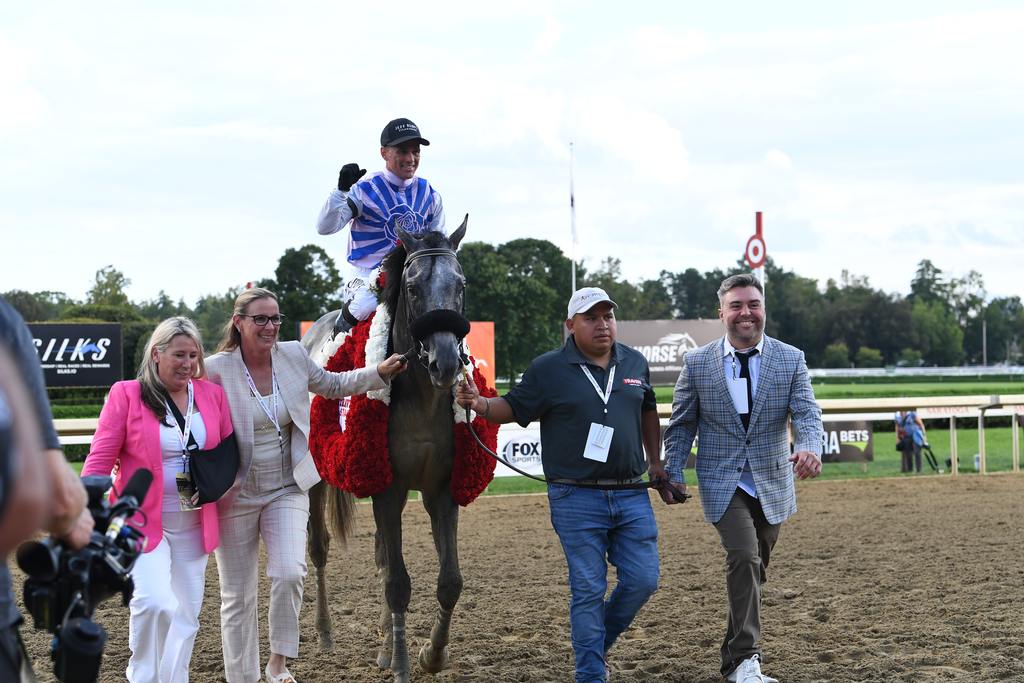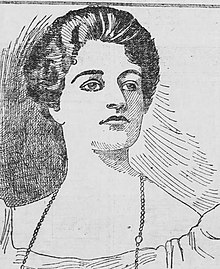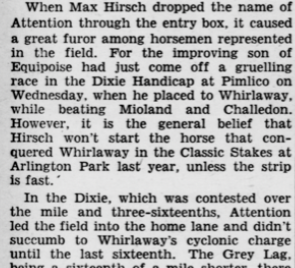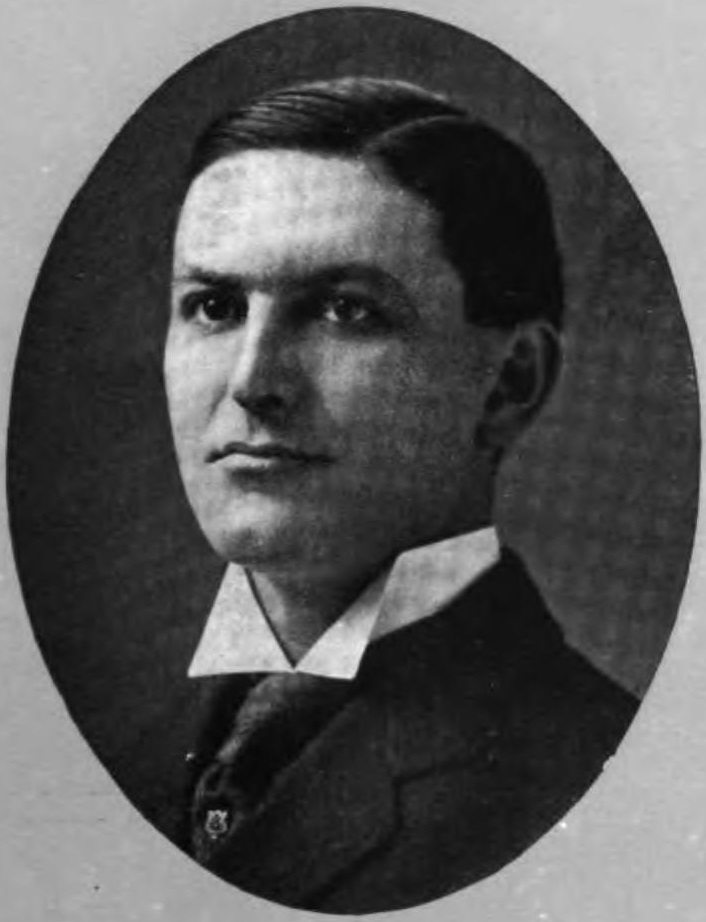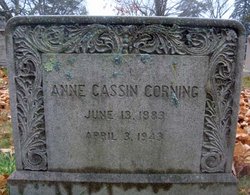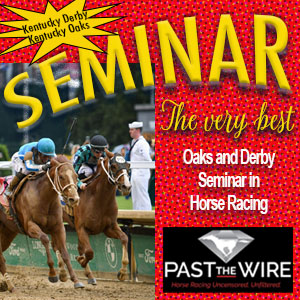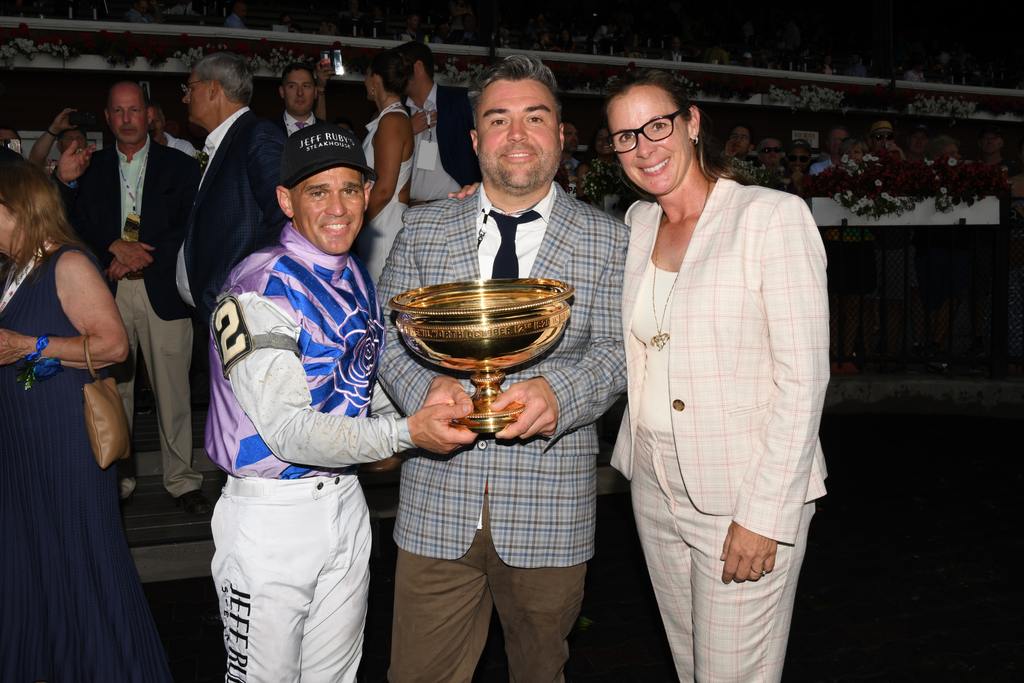
The Owners
Blue Rose Farm’s Jon Ebbert, owner of Arcangelo, holds the Travers trophy flanked by jockey Javier Castellano and trainer Jena Antonucci. (Adam Coglianese)
By Maribeth Kalinich
Jena Antonucci told me that a major part of Arcangelo’s success was having a patient owner in Jon Ebbert. Ebbert admitted he knew his Keeneland purchase would be a project and need time to mature.
Anne Corning’s colt had survived a lightning strike and, although he had heart and speed, left Anne hanging on hope and the edge of her seat too many time with close placing seconds even equaling and breaking time records.
Patience is definitely a commonality between these owners separated by decades.
Corning hired a woman to train her stable in an era dominated by men.
Fate led Ebbert to meet Antonucci at a Keeneland auction.
I knew there was a pretty good story here, folks. Here we go with part two.
THE OWNERS
Anne Corning
Thanksgiving was bred in Maryland by William M. Elder who sold him as a yearling to Anna Corning. The colt joined the Corning stable in 1937 at age two.
Thanksgiving was stabled at Max Hirsch’s barn at Saratoga when that lightning strike occurred that year. After his recovery, Anne asked Mary Hirsch to take over his training as a 3-year-old.
Corning assigned other trainees in her stable to Hirsch, but none would reward like Thanksgiving.
Anne Corning nominated her colt for a number of races in 1938, including the Kentucky Derby and the Preakness.
The colt started off his 3-year-old campaign well placing second but a well-beaten sixth in the Chesapeake Stakes doused Corning’s Triple Crown aspirations.
Facing the 2-year-old champion Menow in the Withers, Thanksgiving would bounce to a second place finish and then win the Constitution Handicap one week later. Yes, one week.
The 3-year-old division was wide open in 1938 with three different Triple Crown winners as racing moved to Saratoga in late July.
After winning the Constitution, Corning’s colt turned in four more performances where he broke track records yet failed to reach the wire first.
Elizabeth Grinnell agreed, writing in Country Life and the Sportsman, “Although he may not be the fastest, I think Thanksgiving may be the most interesting of the lot. Within five weeks this smallish bay colt, in four successive starts at three different tracks, has equaled two track records and broken two others without winning a single race.”
With no clear 3-year-old division leader, an assertive victory would boost Thanksgiving’s standings considerably.
Finally, Thanksgiving achieved a win on July 29th in the Saranac Handicap two weeks before the Travers Stakes.
Under a 22-year-old Eddie Arcaro, who had just won his first riding title at Saratoga the previous year and the Kentucky Derby in May, Thanksgiving would beat a formidable field in a record time.
John Hervey said in 1938 American Race Horses. “[the horse] made all the others look common, leading all the way and winning fairly in a canter by four lengths.”
In his 4-year-old campaign, Thanksgiving won the 1939 Philadelphia Handicap, another historical first for female trainer, Mary Hirsch.
The Philadelphia Handicap was held thirty-eight times between 1913 and 1950 at Havre de Grace Racetrack in Maryland.
Other winners of the Philly were Exterminator (1923), Equipoise (1933 & 1934), who is Anne Corning’s winning horse Attention’s sire; and Challedon (1942).
Also, Billy Kelly who bested his stablemate Sir Barton in the 1918 edition of the race. Favored for the 1919 Kentucky Derby Billy Kelly would lose to Sir Barton, then regarded as lightly raced. However, Billy Kelly would beat Sir Barton in 8 of 12 of their head-to-head races.
Thanksgiving’s record and his Travers will be well discussed in this series. His contribution to Corning, Hirsch and racing history are immeasurable.
The speedy colt with the cheerful name retired in 1940 to stud at the Corning farm where he remained until 1943.
Parker and Anne Corning bred and raced many other horses.
First run October 28, 1936, the New England Futurity was a short-lived race at Narragansett Park in Pawtucket, Rhode Island for two-year-old entire colts and fillies. The Daily Racing Form reported it to be “New England’s richest and most important stake(s).”
On September 28, 1939, over a muddy track, Parker Corning’s Straight Lead won the New England Futurity. The Max Hirsch trainee beat Fenelon from the powerful Belair Stud stable.
The bay colt, who had been claimed by Corning in 1941 for $4,000 was second in the New Rochelle Handicap and finished third in the Pimlico Futurity and Roseben Handicap.
The son of Chance Play out of Dove by Noah won 13 of his whopping 73 starts with nine second places and eight thirds earning $55,975.
In 1940 at the race’s new distance of six furlongs, Robert W. McIlvain’s Walmac Farm’s colt Bushwhacker won the New England Futurity beating the Corning’s 2-year-old New York homebred Attention. Parker was listed as breeder with Anne noted as his owner.
Attention was also second in the Hopeful just before his run at Narragansett. Second to a colt named Whirlaway.
The Equipoise colt followed up two stakes placings with a string of stakes wins in the United States Hotel—beating Whirlaway this time, the National Stallion in 1940 and the Classic in 1941, again beating Whirlaway.
May 6, 1942, Attention was second the Dixie at Pimlico, to Whirlaway. May 16th, he won the Metropolitan Handicap.
The colt followed that up 14 days later with a third-place finish in a race his sire had won in 1933, the Suburban Handicap at Belmont Park. Whirlaway was second behind Market Wise.
A month later, June 27 he would finish third in the Brooklyn Handicap at Aqueduct and third July 15 at Suffolks Downs in the Massachusetts Handicap.
As a 5-year-old Attention would take second again in the Dixie and this time, second in the Suburban—but not to Whirlaway who was retired. The bay would get the victory in the Gittings Handicap.
The son of the great Equipoise out of Fizzaz by Bubbling Over retired with nine wins in 29 starts. He also scored eight seconds, four thirds and $122,000 in career earnings which would equal $2,165,154 today.
After his racing career Attention went to stand at Helis Stock Farm in New Jersey. He died there in 1954 of a heart attack at age 16.
Anne Corning’s personal life was as exciting as her racehorses.
Anne first married wealthy Archibald Jermain McClure after a whirlwind romance. Archibald said he fell in love with her picture in a magazine while traveling in the West. Coincidentally, she lived near Albany, N.Y., where McClure lived. He raced back to NY and courted her, beating out an Italian count who also raced there to woo her. She and McClure had a son, Barclay Jermain. Their marriage lasted 10 years and ended in a much-publicized divorce.
Anne married Parker Corning, a prominent industrialist and later a Congressman, in 1910. Parker was the son of Albany Mayor Erastus Corning.
Anne became widely known in Albany, Long Island and Maine society and was a noted patroness of Thoroughbred horse racing and breeding.
The Lower Farm section of the Erastus Corning Estate, modern day Retreat House Road and River Road area, came to Parker Corning and his wife Anne.
Parker began to rebuild the family’s wealth especially through the development of the Albany Felt Company (later Albany International) which started as a small mill at Kenwood that was supplied by the fleece from the sheep his father raised.
Paul Grondahl describes Parker as someone who moved easily from the worlds of agriculture to society to business to politics. Elected to New York’s 28th District in 1923 he served until in Congress 1937.
The Cornings embarked on a lavish, high-society lifestyle. That lifestyle included swanky parties at their Lower Farm mansion. (They also had five other homes where they lived and entertained as the seasons dictated.)
The couple had one daughter together, Mary Parker Corning, who was born in 1912. Mary Parker enjoyed a privileged childhood, debuting in society with balls and dinner dances in New York City and Long Island. In 1933, Mary married Philip Lawrence Birrell Inglehart.
Sharing the Corning passion for high bred horses Mary was a frequent visitor to the track and polo fields at Saratoga. Her husband Philip was a polo player of notable skill.
Mary also showed her own horse in hunter/jumper classes.
Parker and Anne Corning both died in 1943 and their estate and the Lower Farm came to their daughter Mary. In 1945, Mary donated 43 acres of the Lower Farm to the Catholic Diocese and it became a Jesuit Retreat House.
Thanksgiving was part of the Corning consignment that sold at Belmont Park in May 1943 following the deaths of the Parker and
Anne Cornings. Purchased by Philip Godfrey for $1,700, the Corning stallion would stand at Godfrey’s farm through the 1940s.
By the late 1950s Thanksgiving was standing at Holiday Farm in Michigan and continued siring foals through 1958.
Jon Ebbert
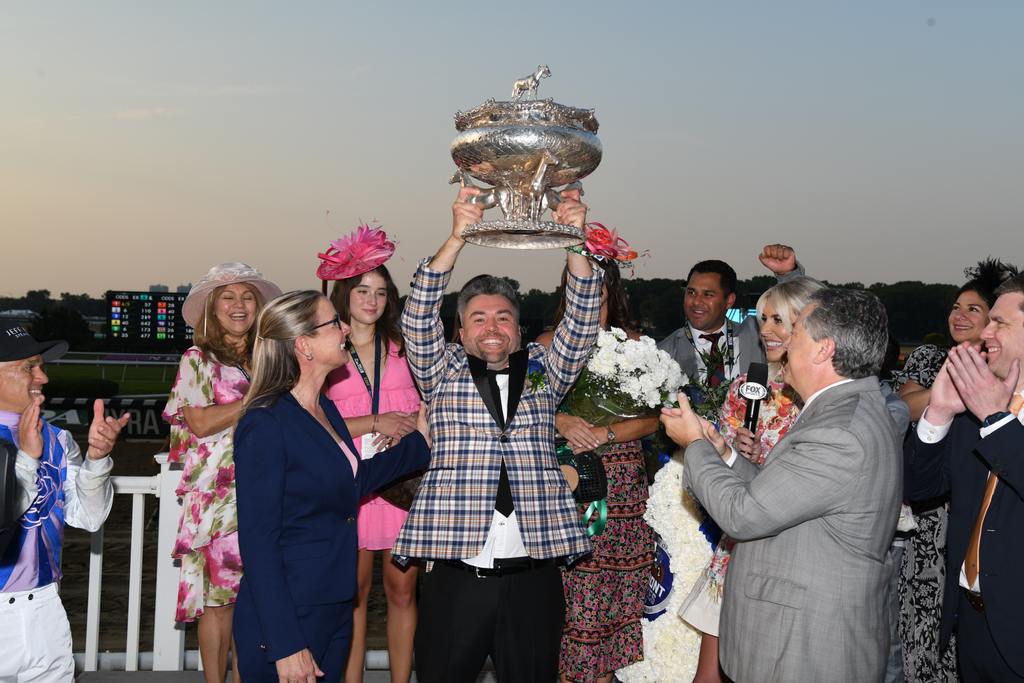
Sitting anxiously as the auction progressed hoping it would be over quickly, it would take Jon Ebbert a minute and a half to buy Arcangelo for $35,000 at the Keeneland 2021 Yearling Sale. He had predicted the Arrogate ridgling would go for $40,000. Any way you look at it, he got a very good deal.
“Luck was on my side when I bought Arcangelo for that price. I got a bargain, but I knew I’d have to spend extra time to let him develop,” Ebbert told Patti Reed in an article for Pennsylvania Racing Association.
What attracted Ebbert to Arcangelo? He was small and far from mature enough to go on the track as early as most 2-year-olds. He was also a ridgling with sesamoiditis.
Ebbert said he happened to be walking the sale when someone was showing the ‘colt’ and there was a spark. “I saw him and locked eyes with him. It was an immediate connection,” he said. “A lightbulb went off.”
Ebbert said he also liked that he was from the Unbridled line. (Arrogate’s grandsire and Modeling’s great grandsire)
And he was a gray.
“I knew he was a project, and he would need time to mature. I thought he’s going to be an amazing older horse. I thought he would mature a little later than he did,” he followed up with.
After he bought Arcangelo, he sent him to be broke at Clovis Crane in Pennsylvania. Ebbert took his time with him, and he stayed there until March of his 2-year-old year. Then he sent him to Jena’s farm in Florida to continue training.
Ebbert had met Jena Antonucci at the Keeneland sale the day before he bought Arcangelo. “Such a blessing meeting Jena at Keeneland,” Ebbert remarked.
The stars were aligning.
Racing under Ebbert’s nom de course Blue Rose Farm, Arcangelo had his first start in the middle of December of his 2-year-old year at Gulfstream Park finished second by 2-3/4 lengths at six furlongs. He opened his sophomore campaign January 14th with a fourth-place finish at one mile to Todd Pletcher’s Kingsbarns.
Then he got a little time to mature and in March the gray ridgling assertively broke his maiden at Gulfstream.
“Arcangelo really matured between December and March. He looked like he gained 100 pounds of muscle,” Ebbert recalled.
The rose was in early bloom.
Maybe it was that chance meeting outside at Keeneland that caused Arcangelo to catch Ebbert’s eye. Or maybe it was he is a little subconsciously sweet on grays.
Ebbert recalled how impressed he was watching filly Winning Colors, a gray, win in 1988. Not only did she win the Kentucky Derby against the boys, but she had previewed with wins in the Santa Anita Derby and the Santa Anita Oaks.
A passion for horses inspired by his grandmother at age six, Ebbert recounted a time when she preferred to stay home to watch the Kentucky Derby rather than go out to dine.
“My grandmother always said bet the grays,” Ebbert told me.
When Ebbert was 8 years old he asked his mother to take him horseback riding. His first hands-on experience with horses. He said he still rides when he can.
Ebbert said he would frequently go to Philadelphia Park (now Parx) to watch racing in his youth and for his 18th birthday he treated himself to a trip to historic Monmouth Park.
When he was about 25, he bought his first Thoroughbred to race under his own name. Daydreamin Boy raced at Philadelphia with lackluster results but that didn’t deter Ebbert.
Ebert, who works in real estate in Pennsylvania, dabbled in partnerships, pinhooking and a little breeding.
“I think the Pennsylvania Breeder’s program is great, and I bred a few mares here to Smarty Jones. I like (the late) Smarty Jones, and I want to support Pennsylvania racing when I can,” Ebbert said to Patti Reed.
As well as campaigning Arcangelo under Blue Rose Farm, Ebbert also still races under his own name. Currently he is campaigning Gustav, a 3-year-old Nyquist colt he bought for $50,000 at the 2020 Keeneland Sale. And Classic Boubon, a 2-year-old son of Classic Empire he ponied up $100,000 for also at Keeneland.
“They were two I was going to pinhook at Ocala but decided to put on the track,” Ebbert said.
Both have made their first starts and both are trained by Jena Antonucci.
As for Arcangelo, what’s next? The future will be the 2023 Breeders’ Cup, a year sooner than Ebbert anticipated, and “whatever Arcangelo tells us he wants to do.” A possibility of a 4-year-old season? Arcangelo will let us know.
“We have patience and will do whatever’s best for the horse,” Ebbert said.
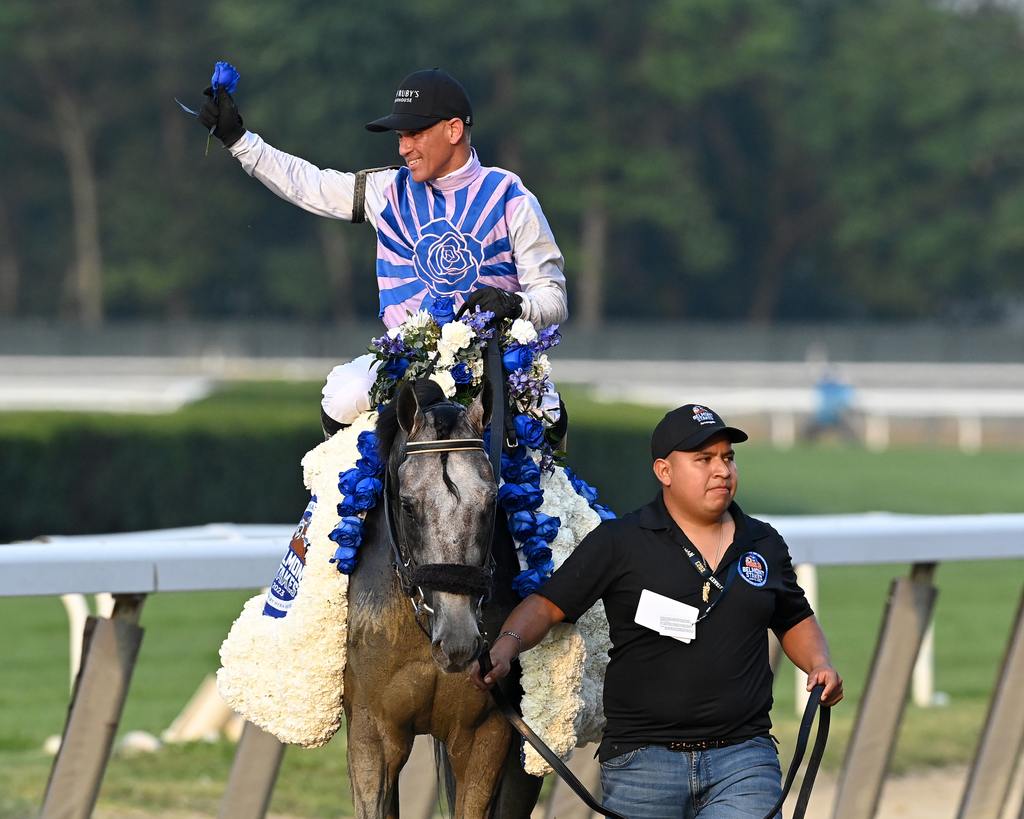
What was the inspiration behind the name Blue Rose, a mythical flower in nature. Ebbert explained. “I was thinking Kentucky Derby roses and a blue rose really doesn’t exist, it’s unobtainable.”
But we know that it does exist now. And looks great on silks and as the garland on the Belmont blanket.
Three days after Arcangelo’s Belmont Stakes victory, Ebbert would celebrate his 40th birthday. Quite a surreal gift he had received. The August Belmont Trophy. Arcangelo still had a surprise for Ebbert to unwrap. But not until August at Saratoga.
Look for Part Three of Barnstormers tomorrow in Past The Wire. To read Part One click here.
